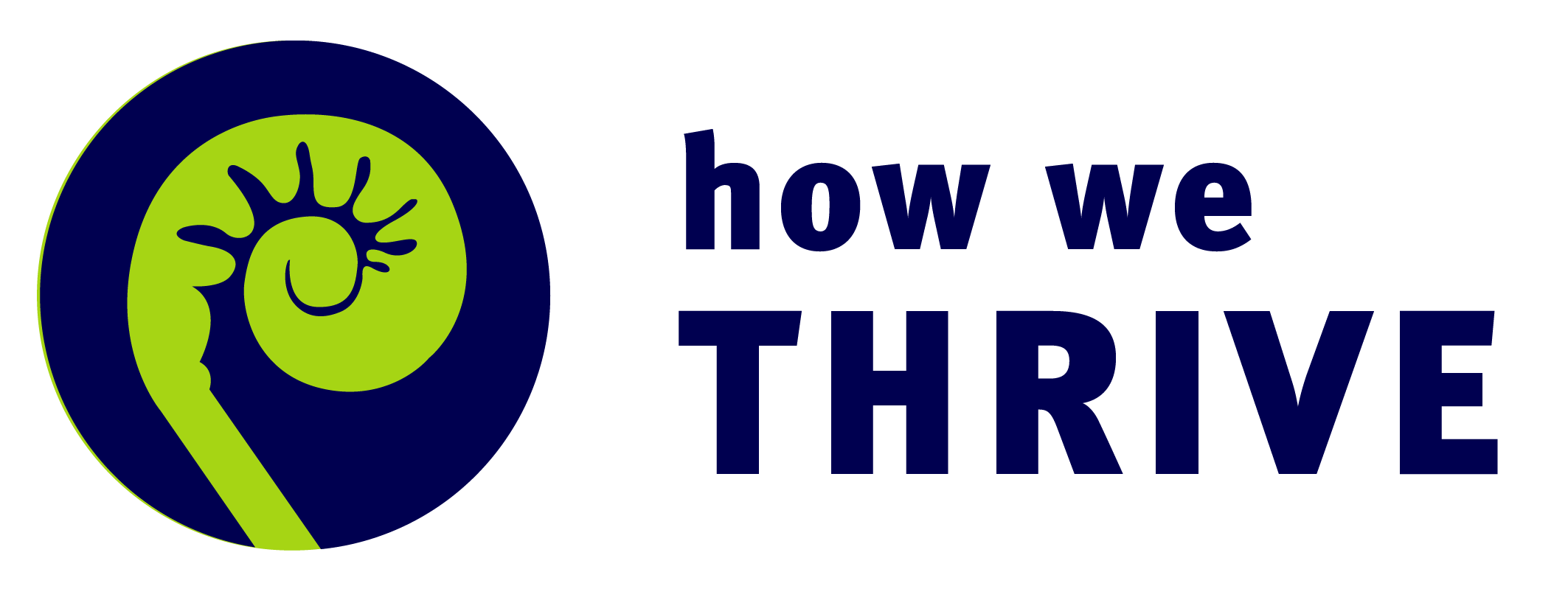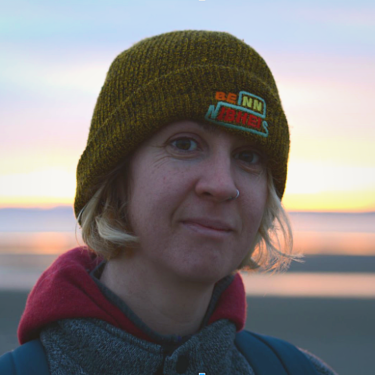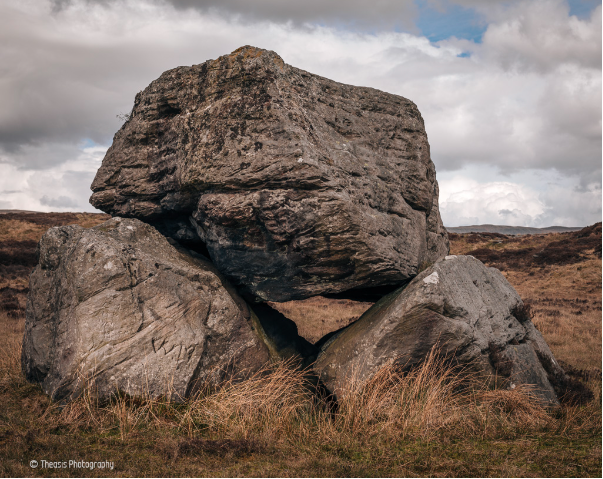Ás an Talamh | Stories from the Land that Sustains Us
February 2, 2024
Host: Màiri Britton
Guest: Ceit Langhorne
Is fheàrr na’n t-òr sgeul innse air chòir | Better than gold is a tale well told
In this visit, host Màiri Britton and her guest Ceit Langhorne led us on a roaming journey to explore the landscapes of the Old Country, their native Scotland. Through names, stories and reflections we considered what it means to see the world through “Gaelic eyes” and the ways in which this understanding of the land can nourish us. This was a conversation rooted in Scotland—the native land of the Gaels. It perhaps offers a starting place for future conversations around the Gaels’ connection to their newer homelands in Mi’kma’ki | Nova Scotia, and how the Gaels’ story weaves with the experiences of the Mi’kmaq, the indigenous stewards of this land.
About Ceit Langhorne
Originally from Glasgow, Ceit Langhorne has been speaking Gaelic for around 15 years, having studied it at Aberdeen University and Sabhal Mor Ostaig. She now lives in Ballachulish, near Glencoe, in North Argyll. Over the last few years, Ceit has enjoyed pursuing an array of creative jobs geared towards interpreting and bringing to light lesser-known aspects of Gaelic cultural heritage throughout the Gaidhealtachd. These projects often happen in areas where Gaelic has significantly declined, but whose Gaelic heritage gives rich insights into past connections between people and environment, and offers imaginative potential to strengthen our connection with nature as we move into the future. The projects have included work around music, local folkloric characters and stories, place name studies and Gaelic in the local natural landscape.
Ceit has worked as a Gaelic consultant for conservation organisations and museums, and collaborated on creative arts projects including an audio play about a rave in a fairy hill! She is currently undertaking a PhD, investigating different stories of characters in the Gaelic Heroic Narrative (Fionn Mac Cumhaill, Deirdre and Naoise, Diarmad and Grainne) and interpreting these stories in the Gaidhealtachd landscapes where they have been historically situated.
’S ann bho Ghlaschu a tha Ceit bho thùs, agus tha i air a bhith a’ bruidhinn Gàidhlig airson 15 bliadhna, ás déidh dhi a h-ionnsachadh aig Oilthigh Obar Dheathain agus Sabhal Mòr Ostaig. Tha i a’ fuireach a-nise ann am Baile a’ Chaolais, faisg air Gleanna Comhain, ann an Earra-Ghàidheal a Tuath.
Fad beagan bhliadhnaichean a-nis, tha Ceit air tlachd fhaighinn ás a bhith a’ gabhail pàirt ann an iomadach pròiseict cruthachail ceangailte ri ath-bheòthachadh diofar eileamaidean de dhualchas na Gàidhlig; ann an àiteachan far an do chrìonaich Gàidhlig o chionn ghoirid. Bidh na pròiseactan sin a' gabhail a-steach ceòl ionadail, càractaran is sgeulachdan ann an dualchas, agus ainmean-àite agus Gàidhlig sa chruth-tìre.
Tha i air obair a dhèanamh mar neach-comhairleachaidh na Gàidhlig airson buidhnean ghlèidhteachais is taighean-tasgaidh. Tha i cuideachd air co-obrachadh air pròiseactan cruthachail, a leithid dealbh-chluiche stèidhichte aig ‘rave’ ann an sithean! Tha i an-dràsta ag obair air PhD, a’ rannsachadh diofar sgeulachdan gaisgeil air a’ Ghàidhealtachd, an cuide ris na h-àiteachan anns an deach na sgeulachdan a stèidheachadh agus na coimhearsnachdan a dh’innis iad.
What we heard
Ceit began by talking about the land that nurtured her in her growing up years—the community of Baldernock, near Glasgow. She spoke of its beauty, but also how the stories of landscape have been mostly lost from that area, something which she found was in contrast to areas where Gaelic had a stronger presence.
“Like everywhere in Scotland we used to have a lot of folk stories, I think, and there are echoes of that . . . but we stopped telling them a long time ago. And when I speak to people at home they don’t really . . . seem to be too bothered that we’ve lost our stories - ‘ach well,’ [they say], ‘you know, things go into forgettance, it’s fine.’ As I learned Gaelic and the more people I spoke to who had Gaelic the more I realised that this is not the norm in the Gàidhealtachd. Even if you don’t have Gaelic up here—I now live in Argyle—you still have this understanding of this land having this really rich cultural heritage.”
Despite the stories sliding into forgettance around Glasgow, however, many of the place names still speak to the presence of Gaelic in the landscape. These names can be found within the vast online database of Ainmean Àite na h-Alba | Gaelic Place-names of Scotland. Baldernock, for example, is Both Eàrnaig in Gaelic, and nearby Craigmaddie comes from Creag a’ Mhadaidh—the fox’s or wolf’s rock.
As Ceit points out, place names can speak to so many features in the landscape, as well as acting as remembrances for people and animals who live(d) there:
“You can’t ignore the fact that the people that these place names describe . . . that they’re no longer there. And you also can’t ignore the absence of the biodiversity that these place name also talk about in the Scottish landscape”
The word madadh commonly means “fox” today, but it most likely referred to wolves in the past. Foraging places, fishing spots and summer pastures, or àirighean, are all remembered through place names. Ceit tells us that any name with ruigh in it probably refers to àirigh, a shieling. There are at least 110 words for hill or mountain(!), some of which offer warnings of potentially treacherous topography. The land is also embodied with words like lurgann (shank, haunch), druim (back) or sùil (eye) to describe its features. In the Gaelic worldview, the land is alive in more ways than one.
These names can be both evocative and entertaining, as we saw when Ceit listed all the variations of the name “goat” to describe different animals. Beach gobhar nan giuthas is a pine hover-fly, literally a wasp-like goat of the pines. On the island of Tiree, snails and whelks are gobhar-breac (spotted goat). Gobhar-adhair (sky goat) is, depending on the area, a curlew, corncrake or snipe. And the dipper is known as gobhar dubh an éisg (black goat of the fish). Sometimes it is gobha uisge, water blacksmith, because their black feathers and white breast resemble a soot-blackened smith with his white chest showing through a partly unbuttoned shirt.
All these details crystallize to offer a distinct experience of the landscape and its inhabitants. As Ceit says, “The Scottish landscape was always magic to me . . . but it’s really kinda transformative if you know Gaelic and if you can engage with the landscape in that very particular way.”
And even around Glasgow, there are some stories which are still remembered, such as the one connected to the Auld Wives’ Lifts on Craigmaddie Muir. Three huge boulders sit in an usual formation in a broad hollow up on the muir. Ceit tells us how three witches or old women came from the neighbouring parishes of Srath Bhlathain (Strathblane), Camaisidh (Campsie) and Both Eànraig (Baldernock) each carrying a massive stone in their aprons. In order to settle an argument, they decided to see who could throw her stone the furthest. The first two women’s stones landed right next to each other on the ground. With a mighty toss, the third woman’s stone landed, perfectly balanced, right on top of the other two.
Through the following centuries people have continued to be drawn to the shape and folklore of the stones, carving names and graffiti on them or crawling through the gap between them as a marriage fertility blessing. Ceit has produced a narrative essay podcast detailing their history which is available on SoundCloud.
This story led into others as Ceit introduced characters from the hero-tales of the Féinne which she is currently studying for her PhD thesis. Acknowledging that Fionn MacCumhaill usually gets the limelight, she told us about Daorghlas, the fastest runner among the Féinne, and how he raced against the Gobha Sìth, a one-eyed, one-legged blacksmith who some reports said had seven arms. After winning the race, Daorghlas was able to gain access to the Gobha Sìth’s smithy, where Fionn’s sword, Mac an Luin, was forged. Ceit also described how the Gobha Sìth came to Scotland, carried by his mother on one shoulder while she carried his smithy on the other shoulder - another tremendously strong woman!
Ceit talked of how she spends a lot of time tracing these stories throughout the landscape in her local area. Knowing exactly where and how far Daorghlas and the Gobha Sìth raced brings the story alive for her: “You have to do some detective work to figure out the contours of these stories—where they were told and how extensively, how old are they? It’s very very rich.”
Mapping names and stories onto the landscape has formed much of the work Ceit does as a Gaelic consultant to environmental and educational organisations such as Trees for Life and the Shieling Project. At the Dundreggan Re-wilding Centre in Genmoriston near Loch Ness, she helps folk see the land through the eyes of its natural inhabitants—the plants, animals and also the local people who, at the start of the 20th century, were entirely Gaelic-speaking.
Behind her own home in Baile a’ Chaolais is Beinn Bheithir, thought to be home of Cailleach a’ Bheithir. A remarkable wooden carving of a female deity was found preserved in a peatbog in the area, dating to 600BC. Ceit talked of the symbolism of the Cailleach, the hag of winter, and how she meets Brìghde at this time to discuss, perhaps to argue, before Brìghde eventually takes over and ushers the land into Spring. Some versions of the Cailleach see her as protector of wild places and the deer herds that roam the Highlands, as depicted in this artwork by Claire Hewitt.
In love with the Gaelic tradition and committed to contributing to its survival and growth, Ceit is learning to tell the stories of her childhood home and the area of the Highlands where she now lives. She tells us that she is greatly inspired by the storytelling of Essie Stewart, one of the last among the Scottish traveller community to be born in a bow tent and grow up doing the Summer Walking (see The Summer Walkers by Timothy Neat). Recordings of Essie’s father, Ailidh Dall, can be found on Tobar an Dualchais. Ceit explained how she particularly appreciates Essie’s calm and understated style of delivery: “it is the story speaking first, the old tradition coming through.” She described Essie’s style as effortless—“she is somebody who really understands the full arc of these traditions and tells them in the old way.”
Whilst we may greatly admire and appreciate a renowned storyteller, however, Ceit is careful to stress that these stories are there for everyone to learn and enjoy. They do not only belong in archives or on stages. With loving and respectful learning we can all be nourished by them, carry them and pass them on.
She leaves us with a song she made for the ‘ùraisgean’, the nature/water spirits of the Scottish Highlands (see the ‘What we Said’ document for song lyrics). Many of us were left feeling inspired, thinking about how we might see even more of the world around us through Gaelic eyes, and how we might continue to draw creativity from its poetry and wild places.
What we said
After listening to the conversation, discussing what we’d heard in the breakout rooms, and then returning to the main room, we shared our reflections in the chat. Below is a sample of our comments. Read the full transcript here, along with more resources and links.
So happy to listen to Gaelic spoken and to hear the stories Ceit told about the landscape
These animal names are just fascinating! Definitely seeing these animals with new eyes.
Talking about being in the landscape, understanding your surroundings is so much part of the culture of the indigenous peoples here in Canada
Land and landscape are important to so many people. A source of comfort. You can understand the longing that some emigrants felt when they never were able to return to their landscapes.
I want to learn more about the Cailleach and the deer. That speaks to me.




